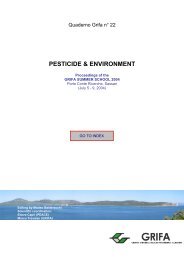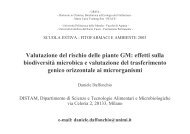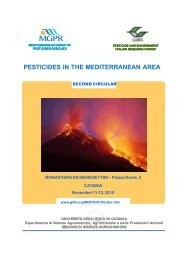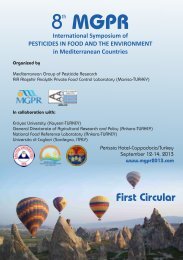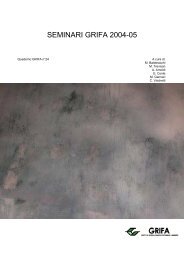International Congress BIOLOGICAL PRODUCTS - Gruppo di ...
International Congress BIOLOGICAL PRODUCTS - Gruppo di ...
International Congress BIOLOGICAL PRODUCTS - Gruppo di ...
Create successful ePaper yourself
Turn your PDF publications into a flip-book with our unique Google optimized e-Paper software.
14<br />
ASSESMENT OF PHYTOTOXICITY TO GRAPEVINE OF TRADITIONAL AND NEW COPPER<br />
COMPOUNDS USED IN COPPER REDUCTION STRATEGIES IN ORGANIC VITICULTURE AND ITS<br />
RELATIONSHIP WITH ENVIRONMENTAL CONDITIONS AND NUMBER OF TREATMENTS<br />
Ilaria Pertot, Marco Delaiti, Diego Forti<br />
Istituto Agrario <strong>di</strong> S. Michele all’A<strong>di</strong>ge, via Mach 1, S. Michele all’A<strong>di</strong>ge, (TN), Italy<br />
ilaria.pertot@ismaa.it<br />
Introduction<br />
In organic viticulture Plasmopara viticola control is based almost exclusively on copper. The expected restrictions on<br />
copper used in organic agriculture in the European Union have stimulated the research of alternatives and the<br />
optimisation of copper allowed quantity. To compare efficacy against downy mildew of <strong>di</strong>fferent copper compounds<br />
several researches have been done, but phythotoxicity has received scant attention, particularly in relation to copper<br />
reduction strategies in organic viticulture. Phytotoxicity risk must be taken into consideration during grapevine<br />
phenological cycle, because copper compounds could affect the quality of grape and the vegetative balance of the plant.<br />
Researches have shown that, using the same Cu2+ dosage, efficacy and rainfastness of <strong>di</strong>fferent copper compounds and<br />
formulations are the same (Pertot et al., 2002). Reduction in annual copper quantity will be possible with a rationale<br />
use of dosages, that can vary between 30 to 70 g Cu2+/hl during the vegetative stage of the plant, depen<strong>di</strong>ng on weather<br />
con<strong>di</strong>tions and infection risk evaluation. The rationale dosages used must be associated with a careful protection against<br />
primary infections, the execution of treatments before forecasted rain and the increasing of frequency application in the<br />
period of maximum plant growth.<br />
Among new copper formulations, compounds and adjuvants only copper peptidate could allow a consistent reduction in<br />
copper annual quantity, giving at the same time a adequate efficacy level against the <strong>di</strong>sease (Pertot et al., l.c.).<br />
The aim of this research was: i) the evaluation, with low dosages, of phytotoxicity to grapevine in field of new copper<br />
formulations compared to the tra<strong>di</strong>tional ones; ii) the identification in controlled con<strong>di</strong>tions of the factors that induce<br />
phytotoxicity.<br />
Materials and metods<br />
The trials were done in the experimental organic vineyard of Istituto Agrario <strong>di</strong> S. Michele all’A<strong>di</strong>ge, located in<br />
Rovereto (TN, Italy). Chardonnay was the used cv. Test products, reference products and untreated control were<br />
arranged in a suitable statistical design (fully randomised design, with treatments replicated four times). Products were<br />
applied using a normal volume of 12 hl/ha, with a four times concentrated sprayer (tab.1). Phytotoxicity assessment was<br />
done following EPPO standars, guideline PP1/135(2). For each repetition twenty five leaves were randomly collected<br />
and classified using a scale depen<strong>di</strong>ng on the symptoms and the percentage of leaf surface affected.<br />
2001<br />
2002<br />
active ingre<strong>di</strong>ent commercial name Cu2+ g/ha active ingre<strong>di</strong>ent commercial name Cu2+ g/ha<br />
bordeaux mixture P. Bordolese Dispers<br />
copper hydroxide Kocide 2000<br />
copper sulphate Cutril<br />
cuprous oxide Cobre Nordox<br />
360, 600, 840<br />
bordeaux mixture<br />
copper hydroxide<br />
copper peptidate<br />
copper peptidate<br />
P. Bordolese Dispers<br />
Heliocuivre<br />
Peptiram 7 (2 times)<br />
Peptiram 7 (3 times)<br />
360, 600<br />
150<br />
copper peptidate<br />
copper peptidate<br />
Peptiram 5<br />
Peptiram 7<br />
300<br />
150<br />
cuprous oxide Cobre Nordox<br />
copper oxychloride ICC0087<br />
360, 600<br />
Tab.1 Field treatments in 2001 and 2002<br />
In greenhouse controlled con<strong>di</strong>tions the influence of temperature (5, 15, 25, 35° C), leaf wetness and number of<br />
treatments (1, 3, 5, 7) on phytotoxicity of copper peptidate (Peptiram 5) was evaluated. Potted plants, cv. Pinot gris,<br />
were used. For each treatment were used five plants with two shoots each. Phytotoxicity evaluation was done using<br />
three classes of intensity: low (from 0 to 0,5 % of leaf surface damaged), middle (from 0,6 to 5%) and high (from 5,1 to<br />
10 %) and in<strong>di</strong>cated as phytotoxicity index.<br />
PDF creato con FinePrint pdfFactory versione <strong>di</strong>mostrativa http://www.secom.re.it/fineprint<br />
84



